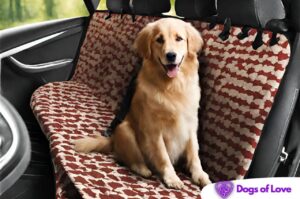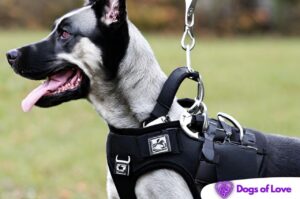The safety and comfort of our four-legged companions are paramount, whether we’re embarking on a leisurely walk or heading out on a car ride.
When securing our dogs during car travel, specialized dog car harnesses have been designed to offer the highest safety and protection.
However, a common question arises: can you use a walking harness in the car?
In this exploration, we will explore the considerations surrounding using a walking harness for car travel, examining the potential advantages and drawbacks and helping you make an informed decision on ensuring your pet’s safety while on the road.

What are the Benefits of Using a Dog Harness in the Car?
Using a walking harness in the car may offer some benefits in terms of versatility and convenience.
One notable advantage is that it allows you to use a single harness for both walks and car rides, reducing the need to switch between different harnesses.
This can be particularly useful for pet owners who frequently transition between walking their dogs and taking them on car trips.
Additionally, many walking harnesses are designed for comfort and ease of use, making it a convenient option for dogs that may not tolerate the confinement of a car-specific harness.
However, it’s important to note that while a walking harness can serve dual purposes, it may not provide the same level of safety and protection as a dedicated dog car harness, which is engineered to withstand the forces associated with sudden stops or impacts in the car.
Therefore, the decision to use a walking harness in the car should consider both convenience and the specific safety requirements of your pet during car travel.
How to Safely Position and Secure the Dog Harness in the Vehicle?
Safely positioning and securing a harness in the vehicle is essential to ensure your dog’s safety during car travel.
If you choose to use a walking harness for this purpose, start by attaching the harness to the car’s seat belt system using a dog seat belt attachment designed to fit most harnesses.
Position your dog in the rear seat, as it’s generally safer than the front seat.
Make sure the harness is securely fastened and that there is no slack in the attachment.
Properly adjust the harness to fit your dog snugly but comfortably, ensuring that it is not too tight or too loose.
Double-check that all straps are correctly placed to distribute force evenly across your dog’s body.
By following these steps, you can help secure your pet in the car and minimize the risk of injury during travel.
How can you ensure your pet is secure and comfortable on the road When Using a Dog Harness in the Car?
Ensuring your pet’s security and comfort on the road when using a walking harness in the car requires some critical considerations.
Firstly, ensure the walking harness is securely fastened and correctly adjusted to fit your dog.
This ensures that your pet is safely restrained during the journey. Position your dog in the back seat, which is generally considered the safest spot in the car.
To enhance comfort, provide your dog with a comfortable and stable surface to sit or lie on, as this can reduce anxiety and motion sickness.
It’s also advisable to secure your dog with a seat belt or a car-specific dog seat to prevent them from moving around and getting injured in sudden stops or accidents.
Regularly check on your pet during the journey, offering treats and reassurance to keep them calm and relaxed.
By taking these steps, you can ensure your pet remains secure and comfortable during car travel while using a walking harness.
What is the safest way to secure a dog in the car?
When securing a dog in the car, the utmost priority is safety.
The safest method for a dog to ride in a car is in the back seat or cargo area, securely fastened with a crash-tested harness, carrier, or crate.
These specialized safety measures are designed to minimize the risk of injury during car travel, distributing the force of sudden stops or impacts and preventing distractions for the driver.
By utilizing these dedicated safety devices, pet owners can ensure the well-being of their furry companions and reduce potential hazards during car rides.
What are the Tips for Taking Care of Your Dog Harness?
Taking care of your walking harness is essential to ensure its longevity and maintain your dog’s comfort and safety during walks.
Regularly inspect the harness for wear and tear, paying attention to any frayed straps, loose buckles, or damaged hardware.
Keep the harness clean by following the manufacturer’s care instructions, which may include hand or machine washing, depending on the material.
Ensure the harness is dry before touching your dog to prevent chafing or discomfort. Proper storage is crucial to prevent damage when the harness is unused.
Store it in a cool, dry place away from direct sunlight and moisture.
Regularly check the fit to ensure it remains snug and comfortable for your dog, significantly if they are still growing.
By following these tips, you can extend the life of your walking harness and provide your dog with a safe and comfortable walking experience.
What are the Reasons You Should Consider Investing In a Dog Harness For Your Car?
Investing in a walking harness for your car can be a thoughtful decision, as it offers several advantages.
Firstly, it provides a versatile solution, allowing you to use a single harness for walking and car travel, reducing the need to switch between different harnesses.
This convenience can save time and make it easier to ensure your dog’s safety during car rides.
Additionally, a walking harness is typically designed for comfort and ease of use, making it a comfortable option for dogs that may not tolerate the confinement of a car-specific harness.
However, it’s essential to weigh these benefits against the specific safety requirements of your pet during car travel, as a dedicated dog car harness is engineered to withstand the forces associated with sudden stops or impacts in the car, providing a higher level of protection.
The decision to invest in a walking harness for your car should consider both convenience and the safety and comfort of your pet on the road.
In conclusion
Using a walking harness in the car is possible, and it offers certain conveniences, such as versatility and comfort for your dog.
It allows you to use a single harness for both walks and car travel, reducing the need for constant switching.
However, it’s essential to strike a balance between convenience and safety. While a walking harness can serve dual purposes, it may not provide the same safety and protection as a dedicated dog car harness.
The latter is precisely engineered to withstand the forces associated with sudden stops or impacts in the car, reducing the risk of injury and distractions for the driver.
Therefore, pet owners should consider their individual needs, prioritize safety during car travel, and ensure their dog’s well-being when deciding whether to use a walking harness in the car.








